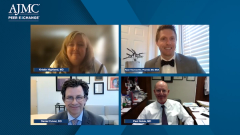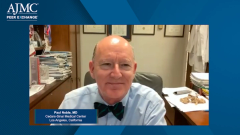
Final Thoughts on ILD
The panel concludes by offering key takeaways for viewers and listeners on ILD therapy.
Episodes in this series

Ryan Haumschild, PharmD, MS, MBA: This has been a really great discussion. Thank you all for this rich and informative talk. Before we conclude, I'd like to get final thoughts from each of you for our viewers. I'll start with you, Dr Culver, what are some final thoughts that you'd like our viewers to take away?
Daniel Culver, DO: I think that the treatment of interstitial lung disease is really just at the beginning. This is the first inning. We have a lot of thing to learn. We have a lot of therapies to explore. I think we're going to see that science is going to guide us, and that this is going to be something that requires more investment by sponsors and also willingness from payers to go down that road a little bit. We may not have perfection on everything immediately, but we have to iteratively try to improve treatment and evaluation for our patients. That may be in some fits and starts. It may not be with thousands of patients [in] randomized trials every time. I think when you look at the output, which is, are the patients feeling, functioning, and surviving better, you will see progress. For these diseases, some of which are not that common, I think that's the way we're going to have to go.
Ryan Haumschild, PharmD, MS, MBA: Thank you. I want to move on to Dr Highland. What is your final thought for us, from everything you've spoken about today that you want our viewers to leave with?
Kristin Highland, MD: I'd like to echo Dr Culver's comments about the complex pathobiology of these diseases and the fact that we often do need to target multiple pathways in connective tissue diseases, especially the fibrotic pathway and the immunologic pathway, and often the vascular pathway, which results in a lot of complexity. There should be a push towards getting these patients to expert centers and a push towards allowing us to do the diagnostic tests that we need and have access to the therapies for these patients. I'd also like to again plead with the payers to lessen restrictions on things like oxygen and portable concentrators and access to pulmonary rehabilitation, which is part of the global care of a patient with interstitial lung disease.
Ryan Haumschild, PharmD, MS, MBA: You've done a great job with your pleads and actually they've been very scientific. At the end of the day, it benefits our patients. If we can better manage these patients, we can reduce health care resource utilization and provide better reductions in total cost of care, which is important to the bottom line of the employer groups and the payers. I think your point's well taken. Dr Noble, I'm going to look to you to finish this out with final thoughts today around this discussion of interstitial lung disease.
Paul Noble, MD: First of all, I really appreciate the comments of everyone. I've learned a lot today and it's been great. What I would close with really is how far we have come. When I was a pulmonary fellow, we treated people with high-dose steroids and cyclophosphamide, and I’m pretty much convinced I did more harm than good. Except for that rare patient that had scleroderma then 10 years later I ended up curing their lung disease without knowing what I was doing. I really think for this audience, adherence, follow up and adherence. We have come a long way in diagnosing patients earlier. I do believe that if we can identify the disease, get people on proper therapy, get mycophenolate paid for, even if it's not always incredibly obvious. It's generic, it's not that expensive. If we can get our patients to stay on the medications; that’s where it's a really a community, it's the physician, it's the family of the patient, it's the nurses, it's the respiratory therapist, it's the payers, and the pharmacists. We're fortunate at Cedars-Sinai Medical Center [Los Angeles, California], we have a great pharmacy group, but really we have to work together with the goal of keeping patients on therapy, modifying doses if we have to. Right now, yes, we have hope for the future that we'll see people with FVCs [forced vital capacity] improving, but right now we need to be able to get people on therapy and keep them on therapy.
Ryan Haumschild, PharmD, MS, MBA: It really is wraparound care throughout that continuum because there is a lot of different changes in treatments that are going on.
Paul Noble, MD: AndI would just also like to echo Dr Culver's great comments about end-of-life issues. It is also incredibly important, for our patients.
Ryan Haumschild, PharmD, MS, MBA: Thank you all again, and thank you to our viewing audience. We hope you found this AJMC® Peer Exchange to be useful and informative.
This transcript has been edited for clarity.
Newsletter
Stay ahead of policy, cost, and value—subscribe to AJMC for expert insights at the intersection of clinical care and health economics.









































